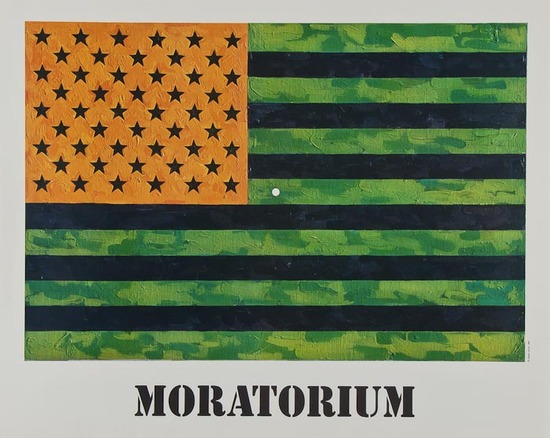
Jasper Johns, Ventriloquist, 1983, image via: MFAH
And now to the second oldest tab in my browser, an essay by Barbara Rose on Jasper Johns’ references to works by Barnett Newman, which accompanied an excellent 1999 show of Johns’s and Newman’s editions at Brooke Alexander Gallery.
From his earliest days in New York, Johns saw and collected Newman’s work, and Rose proposes an ongoing personal relationship between the artists that can be seen in Johns’s work, even from the very beginning:
In the paintings he exhibited at Betty Parsons [in 1951 and 1952], Newman accomplished a goal Pollock was also intent on resolving; he eliminated the distinction between figure and ground. Instead of separating one from the other, he proposed a format in which the image was identical with the field, with no background left over. No shapes were depicted, not even as flattened silhouettes. Rather the field was divided into regular zones. This is of course the format of the iconic Flag that Johns dreamed of and then painted for the first time in 1954. Because Johns’ image is both literal and identifiable, his medium is encaustic rather than oil, and he is more of an easel than a mural scale painter, the obvious debt of the horizontal bands of the flag, which line up to the horizontal framing edge as Newman’s “zips” line up to the vertical frame, has hardly been noticed.
In the 80s, Johns began inserting pictures within pictures, both of his own artworks and works he collected.

Barnett Newman, Untitled, 1961, image via baeditions
Rose discusses several examples of these autobiographical works, including Ventriloquist, top, which includes a mirrored/reverse image of Newman’s 1961 lithograph, Untitled, which Johns owns, and the artist’s own inverted double flag, a color combination Johns used for a 1969 fundraising edition/protest poster for the Committee Against the War in Vietnam. [The unsigned poster version, below, says “MORATORIUM” on the bottom; the signed, numbered edition does not. Maybe the customers for the more expensive version preferred their Johns Flags straight, so to speak, with less politics.]

Johns’ 1969 Flag (Moratorium) poster sold for just £300 last Spring
Anyway, two interesting things Rose doesn’t really get into much: the way Johns makes work about [and with] work he collects, not just work he admires. It’s something that would resurface later in his Catenary series, which seem to relate directly to an early Rauschenberg combine Johns owned, then sold, which has the shroud lines from a small parachute hanging off it. And the resonance this picture-in-picture construct has to Rauschenberg’s Short Circuit. I’ve always thought that Short Circuit was an outlier somehow for incorporating works by other artists; but it turns out that Johns himself eventually began doing something similar in his own paintings and prints.
Johns & Newman: An Encounter In Art, by Barbara Rose [baeditions]
Previously: Johns and Manet’s Execution of Maximilian
